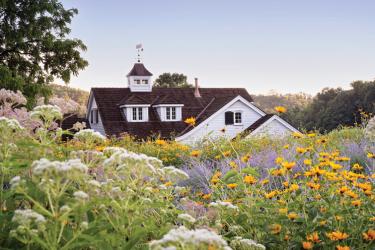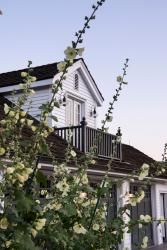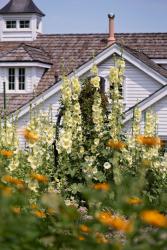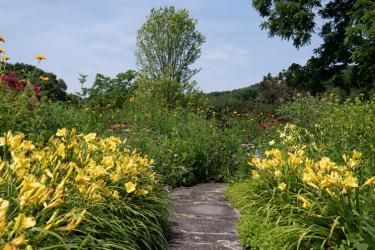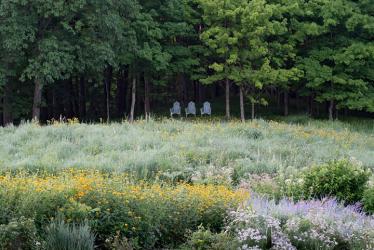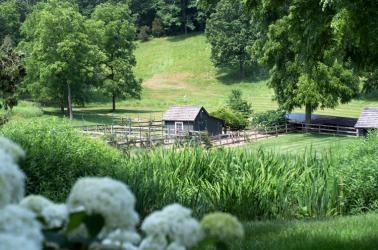The homeowner’s driving directions could not be more simple. To discover Top of the Hill Farm, you just keep going. Down the one-lane road, past every turn-off. When you can go no farther, you have arrived.
The journey to the end of the road leads to another, gentler world that seems suspended in time; a world encompassing eye-level, soft yellow hollyhocks, shoulder-brushing yellow and purple coneflowers and tunnels of gray-blue Russian sage. The drone of hundreds of bees populating the red and purple bee balm and pink and white yarrow provides an auditory rhythm to the color, beauty and exuberance of the garden. Soaring and dipping monarchs and swallowtails light on coneflowers and milkweed. Darting hummingbirds and the whir of their wings add both sound and continual movement to the waves of flowers. The floral borders lining a stone pathway culminate at a white farmhouse with a welcoming, veranda-style front porch.
Other pathways lead away from the house, traveling along rail fences draped with purple clematis and on to a green, 150-year-old barn nestled into a hillside bank. There are vegetable gardens overflowing with plump, red tomatoes and patches with juicy, ripe blackberries just ready to be plucked.
Rail fences enclose a chicken house and yard and stands of native grasses back the dams used to create two lakes and a pond.
On the front porch and throughout the property, Adirondack-style chairs provide an invitation to stop, sit and take in all that nature has to offer. It is a setting that radiates joy, glows with love and above all reflects appreciation and gratitude for the bounty of the earth.
“I like to think it is what you would find at the end of a road if you were driving in England or Ireland,” the homeowner says simply.
The homeowners sowed the first seeds of Top of the Hill Farm 33 years ago when they purchased a multi-acre property that included a log cabin dating from around 1830. At that time, there was no road to the cabin. “We had to chop our way in with a machete,” the homeowner recalls.
It was just what the couple sought. Barely over the St. Louis County line in Franklin County, it was a world away from the hectic pace of retail sales and food service that filled their days, especially on weekends. “We needed a place of refuge to get away during the week,” he says.
In pursuit of a historic barn to add to the property, they cemented their vision for that refuge. “During my search for the ‘right’ barn in the 1990s,” the homeowner recalls, “and our travels in Vermont and New England we learned of (famed children’s book illustrator and author) Tasha Tudor. We were simply in awe of her love and respect for her cottage gardens and the simple appreciation of flowers. We collected all of her books on gardening and cooking, and they fit in perfectly with our life at the end of the road.”
Fast forward 30 years and the barn, eventually found near Orrville, Ohio, and dating from 1850, now encloses 3,200 square feet. It is continually being transformed and used for gathering and entertainment space as well as storage. When he was born, their now adult son became the 25th grandchild, so family events can become large.
The logs of the historic cabin now serve as walls for the couple’s dining room with numerous rooms having been added to the living space. The state-of-the-art kitchen is positioned to catch the first rays of the morning sun. Although the house has grown “bigger than we originally wanted”, he notes, it is designed so that views of it from around the property are not overwhelming and fit perfectly into the landscape
The wife's talent as an artist is obvious in the architecture of the house designed by famed architect and good friend, Dick Busch. Views out every window act as frames for a different painting; a barn framed by native hibiscus here, a lake and a hillside there.
Their joy in the property reflects a perfect partnership, according to the husband. “We grew up in Chesterfield, and I am one of nine kids. My mother loved flowers of all kinds. I get the flowers growing, and she likes to paint them. We have bouquets of flowers all over the house. It works out well for both of us.”
The garden, he notes, took shape little by little over time. “We added a little bit each year and after a while, it all adds up.” A desire to preserve and enhance the ecosystem played a huge role in plant selection. “We read books and talked to people. The Missouri Botanical Garden was a good source of information.”
Preference went to flowers that attract butterflies, hummingbirds and bees. From a start with two beehives, the property now supports 28 hives.
The couple rises early and often sits outside to watch the sunrise before starting their day. “It is amazing how much you can get done in an hour and a half early in the morning if no one is bothering you,” he says with a laugh. “We also are lucky enough to have guys at the store who love to come out here and help out,” he adds.
Perennials and annuals mix throughout the garden. The homeowners collect seeds each fall and store them in burlap bags over the winter to sow in the spring. The plant list for the property encompasses over 40 different species, most of them native. The emphasis is on plants that will take hold and thrive without a lot of fuss and fertilizer.
“The scope of it lends itself to being a little eclectic. It is not a manicured garden,” he emphasizes. “It all fits in with one another.”
Watching the garden take shape has given the couple a “sheer appreciation” for nature, “planting the seeds that magically come up and provide five months of incredible beauty. We don’t have a place at the lake or anything,” he adds, noting that living in their historic farmhouse and being surrounded by their own garden makes home a favorite destination.
“We are only the fourth owners of this property,” the homeowner says. “We felt like we needed to be good stewards of the land. We’ve added a little bit each year. If you live long enough, you end up with something beautiful at the end of the road.”


